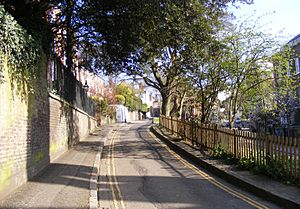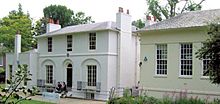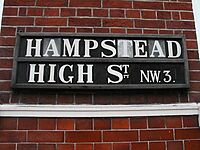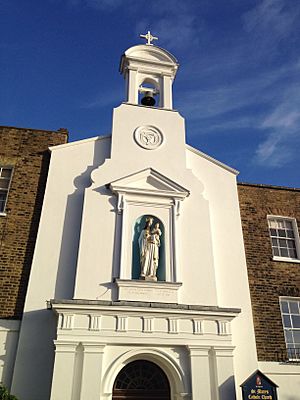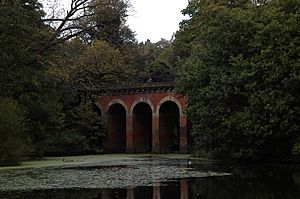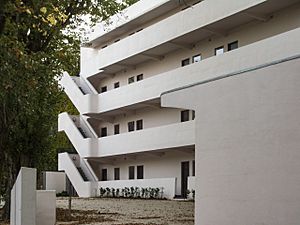Hampstead facts for kids
Quick facts for kids Hampstead |
|
|---|---|
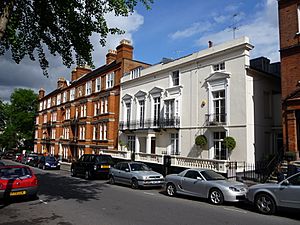 Downshire Hill in May 2009 |
|
| OS grid reference | TQ265855 |
| London borough | |
| Ceremonial county | Greater London |
| Region | |
| Country | England |
| Sovereign state | United Kingdom |
| Post town | LONDON |
| Postcode district | NW3 |
| Dialling code | 020 |
| Police | Metropolitan |
| Fire | London |
| Ambulance | London |
| EU Parliament | London |
| UK Parliament | |
| London Assembly |
|
Hampstead is a famous area in London, England. It's about 4 miles (6.4 km) northwest of the city center. This area is known for its beautiful Hampstead Heath, a large park with hills and open spaces.
Hampstead is a popular place for people who love art, music, and books. Many famous writers, artists, and thinkers have lived here. It has some of the most expensive homes in London. Many well-known people, both from the past and present, have called Hampstead home. These include Helena Bonham Carter, Agatha Christie, Sigmund Freud, Stephen Fry, Ricky Gervais, and Harry Styles.
Hampstead has been home to more Prime Ministers and millionaires than any other area in the United Kingdom.
Contents
History of Hampstead
What's in a Name?
The name Hampstead comes from old Anglo-Saxon words. Ham and stede together mean "homestead." This is like the modern English word "homestead," which means a home and the land around it.
Early Days to the 1900s
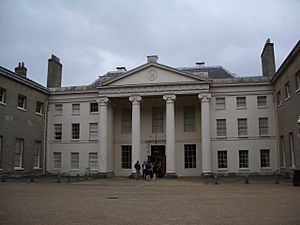
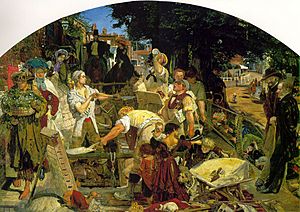
We can find records of Hampstead from a very long time ago. King Ethelred the Unready mentioned it in a document in 986 AD. It was also in the Domesday Book in 1086, which was a big survey of England.
Hampstead started to grow a lot in the 1600s. People discovered that the water from its wells had special minerals. They believed this "chalybeate" water could help people feel better. So, Hampstead became a popular spa town in the 1700s.
However, its popularity went down in the 1800s. Other spa towns became more fashionable. The old spa building was taken down in 1882, but a water fountain was left.
Hampstead grew even more when railways arrived. The North London Railway opened in the 1860s. Then, the Charing Cross, Euston & Hampstead Railway opened in 1907. This made it much faster to travel to central London. Because of this, many fancy houses were built in the 1870s and 1880s. Many of these beautiful homes are still there today.
Hampstead in the 20th Century
In the 1900s, several important buildings were built in Hampstead:
- Hampstead tube station (1907): This is the deepest station on the London Underground network.
- Isokon building (1932): A famous apartment building.
- 2 Willow Road (1938): A unique house designed by a famous architect.
- Royal Free Hospital (mid-1970s): A large hospital.
Hampstead also has many cultural places to visit. These include the Freud Museum, Keats House, and Kenwood House. The old Hampstead Library and Town Hall is now a center for creative businesses.
On August 14, 1975, Hampstead had a record-breaking rainfall. It rained 169 mm (about 6.6 inches) in just 155 minutes! This was the highest amount of rain in such a short time ever recorded in the UK.
Geography of Hampstead
Hampstead became part of the County of London in 1889. In 1899, it became the Metropolitan Borough of Hampstead. The old Hampstead Town Hall was a famous place for celebrity weddings. In 1965, Hampstead joined with other areas to form the London Borough of Camden.
Today, some people think Hampstead is just the main town area. Others think it also includes nearby places like South Hampstead, Belsize Park, and West Hampstead.
Places to See in Hampstead
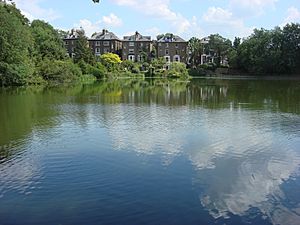
Parks and Views
To the north and east of Hampstead is Hampstead Heath. This is one of London's biggest and oldest parks. From Parliament Hill on the Heath, you can see an amazing view of the London skyline. Many Londoners come here to walk and enjoy the fresh air.
The Heath has three outdoor swimming ponds. One is for men, one for women, and one is for everyone. These ponds used to be places to store drinking water. The bridge you see in the picture is called 'The Red Arches' or 'The Viaduct'. It was built a long time ago, hoping that houses would be built on the Heath, but that never happened.
Fun Activities
You can find many fun things to do in Hampstead. In summer, there are big outdoor concerts near Kenwood House. There are also book readings, poetry events, and fun fairs on the Heath. You can even hear old harpsichord music at Fenton House.
Important Buildings
The Royal Free Hospital is the biggest employer in Hampstead. Many smaller businesses in the area are also well-known around the world. For example, George Martin's AIR recording studios are in a converted church. This is where many famous musicians have recorded their songs.
Hampstead has some very interesting buildings. The Isokon building in Lawn Road is one example. It's a special apartment building that was once home to famous people like Agatha Christie and Henry Moore.
Churches and Synagogues
Hampstead has many places of worship:
- Christ Church
- Heath Street Baptist Church
- St. Andrew's United Reformed Church
- St John-at-Hampstead
- St John's Downshire Hill
- St Luke's
- St Mary's Church (Roman Catholic)
- Rosslyn Hill Unitarian Chapel
- Village Shul (synagogue)
St Stephen's Rosslyn Hill was built in 1869. After being closed for many years, it was fixed up and is now a community center. It hosts educational events, weddings, and concerts.
Museums to Explore
Hampstead has several museums where you can learn about history and art:
- Fenton House
- Freud Museum: This was the last home of Sigmund Freud, a very famous thinker.
- Burgh House & Hampstead Museum
- Keats House Museum: The home of the famous poet John Keats.
- Kenwood House
Theatres and Cinemas
If you like movies or plays, Hampstead has places for you:
- Everyman Cinema, Hampstead: One of the oldest cinemas in the world.
- Hampstead Theatre
- Pentameters Theatre
Art Galleries
Hampstead used to have many art galleries. Now there are fewer, but some good ones remain:
- Catto Gallery
- Gilden's Art Gallery
- Zebra One Gallery
Traditional Pubs
Hampstead is famous for its old-fashioned pubs. Some of them have a lot of history:
- The Holly Bush: This pub used to be lit by gas lamps.
- The Spaniard's Inn: A highwayman named Dick Turpin supposedly hid here a long time ago.
- The Old Bull and Bush
- The Old White Bear
- The Flask
- Freemasons Arms
- The Duke of Hamilton
- The Horseshoe
- King William IV
- The Magdala
- The Garden Gate
- The Wells Tavern
Restaurants and Food
Hampstead has been a place where new cafes and restaurants try out their ideas. Some, like Giraffe World Kitchen and Gail's, became big chains. You can find all kinds of food here, from French to Thai.
There's also a very popular street food vendor called La Creperie de Hampstead. Many famous people visit it!
Schools
Hampstead has many schools. You can find a full list at List of schools in Hampstead.
Hampstead in Movies
Hampstead's beautiful, natural look makes it a great place for filming movies.
- The Killing of Sister George (1968) was filmed in the streets and alleys of Hampstead. The pub in the movie was actually The Holly Bush.
- The Collector (1965) had a kidnapping scene set in Mount Vernon.
- Parts of An American Werewolf in London (1981) were filmed on Hampstead Heath and nearby streets.
- Kenwood House was used in a scene for the movie Notting Hill (1999).
- The Wedding Date (2005) shows Parliament Hill Fields on the Heath.
- Notes on a Scandal (2006) also features Parliament Hill.
- The old Hampstead Town Hall was in Four Weddings and a Funeral (1994).
- The movie Allied (2016), starring Brad Pitt, filmed a family home scene in Hampstead.
- The Cruella de Vil Mansion from the movies 101 Dalmatians (1996) and 102 Dalmatians (2001) is on West Heath Road in Hampstead.
People of Hampstead
The people who live in Hampstead are from many different backgrounds. In 2021, most people living in the Hampstead Town area were white (about 77.7%). The next largest group was Asian (about 8.9%).
When it comes to religion, about 32.6% of people were Christian, and 11% were Jewish. A large number, 37.9%, said they had no religion.
Getting Around Hampstead
Trains and Tube
Hampstead has its own Tube station on the Northern line. This line connects to other parts of London at stations like Camden Town and King's Cross.
The London Overground also has stations nearby, like Hampstead Heath and Finchley Road & Frognal.
Here are the stations in or near Hampstead:
- Belsize Park

- Finchley Road


- Finchley Road & Frognal

- Hampstead

- Hampstead Heath

- Swiss Cottage

Most of these stations are in London's Zone 2 for travel. Hampstead station is in both Zone 2 and Zone 3.
Buses
There's a main bus stop near Hampstead Heath station, close to the Royal Free Hospital. You can catch routes 24 and 168 from here. Other routes like 46, 268, C11, and N5 also stop at the hospital.
Hampstead Tube station and High Street are served by routes 46, 268, 603, and N5. Route 210 runs along the northern edge of Hampstead.
Cycling
Cycling in Hampstead can be a bit tricky. There are bus lanes on Finchley Road (A41) that cyclists can use. A path for both walkers and cyclists runs through the middle of Hampstead Heath, from Parliament Hill to Jack Straw's Castle.
Roads
The A41/Finchley Road goes through Hampstead from north to south. It connects the area to Marylebone and Oxford Street in the south. To the north, it goes to Golders Green and the M1 motorway.
The A502/Hampstead High Street runs from Camden Town in the south, through Hampstead, to Golders Green in the north-west.
Nearby Places
The Royal Free Hospital and its emergency room are in Hampstead.
Famous People from Hampstead
Hampstead has always been a place where smart and creative people live. Many writers, artists, and thinkers have called it home. In the late 1800s, it became a center for a "bohemian" community, which means people who lived in an artistic and unconventional way.
After 1917 and again in the 1930s, many artists and writers who were ahead of their time moved here. It also welcomed people who had to leave their home countries, like those from the Russian Revolution and Nazi Europe.
Blue Plaques
You can find at least 60 English Heritage blue plaques in Hampstead. These special blue signs are put on buildings to show that a famous person once lived there.
Local News
As of 2014, the local newspapers were the Hampstead and Highgate Express, often called the "Ham and High," and the free Camden New Journal. The area is also home to the political magazine Tribune and the funny magazine Hampstead Village Voice.
Images for kids
See also
 In Spanish: Hampstead (Londres) para niños
In Spanish: Hampstead (Londres) para niños



